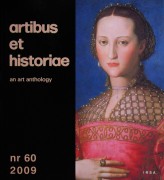 Artibus et historiae, sous-titrée « an art anthology », est une revue d’histoire de l’art publiée en Pologne par l’IRSA (Istituto per le Ricerche di Storia dell’Arte) et contenant des articles écrits indifféremment en français, italien, anglais et allemand.
Artibus et historiae, sous-titrée « an art anthology », est une revue d’histoire de l’art publiée en Pologne par l’IRSA (Istituto per le Ricerche di Storia dell’Arte) et contenant des articles écrits indifféremment en français, italien, anglais et allemand.
Créée en 1980, elle paraît deux fois par an sous un format relié qui lui donne l’aspect d’un livre plutôt que d’une revue. Elle bénéficie d’une aura prestigieuse en raison de la qualité des textes qu’elle propose. Son comité éditorial est composé de nombreux historiens de l’art connus, originaire de nombreux pays, dont Pierre Rosenberg.
Mal diffusée en France, on peut, pour y souscrire ou commander d’anciens numéros, passer par son site Internet.
Edward J. Olszewski, Bring the Clones : Pollaiuolo’s Battle of Ten Nude Men
Janet Cox-Rearick, Power-Dressing at the Courts of Cosimo de’ Medici and François I : The "moda alla spagnola" of Spanish Consorts Eléonore d’Autriche and Eleonora di Toledo
Kristin A. Triff, Rhetoric and Romanitas in Thirteenth-Century Rome : Nicholas III and the Sancta Sanctorum
Jean K. Cadogan, The Chapel of the Holy Belt in Prato : Piety and Politics in Fourteenth-Century Tuscany
Mojmir Frinta, Observation on Michel Sittow
Rosamond E. Mack and Mohamed Zakariya, The Pseudo-Arabic on Andrea del Verrocchio’s David
Pavel Kalina, European Diplomacy, Family Strategies, and the Origins of Renaissance Architecture in Central and Eastern Europe
Marilyn Aronberg Lavin, Art of the Misbegotten : Physicality and the Divine in Renaissance Images
Wendy Bird, Goya and the Menippus Satire : New Light on The Strolling Players, Yard with Madmen and Later Works
Avigdor W.G Posèq, A Proposal for Rembrandt’s Two Versions of Slaughtered Ox
Andrei Nakov, Is critica d’arte a Relic of the Past ? On the New Definition of the Image Victim of a Misinterpreted Russian Avant-Garde
